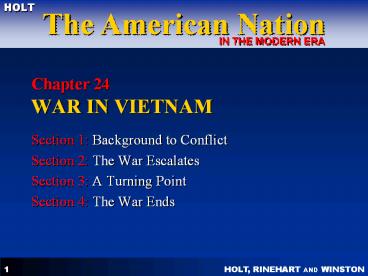Chapter 24 WAR IN VIETNAM - PowerPoint PPT Presentation
Title:
Chapter 24 WAR IN VIETNAM
Description:
Chapter 24 WAR IN VIETNAM Section 1: Background to Conflict Section 2: The War Escalates Section 3: A Turning Point Section 4: The War Ends Objectives: Why did China ... – PowerPoint PPT presentation
Number of Views:125
Avg rating:3.0/5.0
Title: Chapter 24 WAR IN VIETNAM
1
Chapter 24 WAR IN VIETNAM
- Section 1 Background to Conflict
- Section 2 The War Escalates
- Section 3 A Turning Point
- Section 4 The War Ends
2
Objectives
Section 1 Background to Conflict
- Why did China and France want to control Vietnam?
- Why did the United States refuse to support
Vietnamese independence in the 1940s and 1950s? - Why did President Kennedy increase U.S.
involvement in Vietnam?
3
Reasons for wanting control of Vietnam
Section 1 Background to Conflict
- China wanted Vietnams agricultural resources.
- France was imperialistic and wanted colonial
possessions.
4
Lack of American support for Vietnamese
independence
Section 1 Background to Conflict
- valued France as an ally against communism
- disliked Ho Chi Minhs affiliation with Communist
Party - feared the domino effect in Southeast Asia
5
Reasons for increasing American involvement
Section 1 Background to Conflict
- Kennedy believed in the domino theory.
- Kennedy wanted to improve U.S. image in the world.
6
Objectives
Section 2 The War Escalates
- What constitutional issue did the Tonkin Gulf
Resolution raise? - What strategies did U.S. forces use in the
Vietnam War? - What role did the media play in the Vietnam War?
- Why did some Americans oppose the war, and how
did the government respond?
7
The Tonkin Gulf Resolution and the Constitution
Section 2 The War Escalates
- The Tonkin Gulf Resolution gave the President the
power to respond to aggression without
Congressional approval, which meant Congress gave
up its constitutional power to declare war.
8
U.S. strategies
Section 2 The War Escalates
- escalation
- bombing of targets in the North, then areas of
Laos and much of South Vietnam - use of defoliants and napalm
- search-and-destroy missions
- pacification
9
Role of the media
Section 2 The War Escalates
- fewer press restrictions than ever before
- showed graphic images of the horror of war
- gave information concerning corruption in Diem
regime and ineptitude of South Vietnamese troops - caused Americans to doubt whether the war was
right - caused Americans to doubt if the war could be won
10
American opposition to the war
Section 2 The War Escalates
- opposed all wars
- thought Vietnam War took money from social
programs - believed Vietnam was not crucial to U.S. security
- feared that nuclear weapons would be used
Government response
The government insisted that the U.S. was
defending an ally against aggression.
11
Objectives
Section 3 A Turning Point
- Why did the Tet Offensive weaken many Americans
confidence in their government? - What were the key events of the 1968 presidential
campaign? - How did President Nixon attempt to end the war?
- How did Americans react to President Nixons plan
to end the war?
12
The Tet Offensive
Section 3 A Turning Point
- revealed that no part of South Vietnam was secure
- exposed how few South Vietnamese supported their
own government - revealed how determined the North Vietnamese were
13
Key events in 1968 campaign
Section 3 A Turning Point
- March McCarthy nearly ties Johnson in the New
Hampshire primary. - March 31 Johnson withdraws.
- June Robert Kennedy wins California primary and
is assassinated. - August Police attack antiwar protesters at
Democratic convention in Chicago. - November Nixon wins.
14
Nixons attempts to end the war
Section 3 A Turning Point
- begins Vietnamization and gradual withdrawal of
American troops - orders widespread bombing in Cambodia
15
American reaction
Section 3 A Turning Point
- Bombing and invasion of Cambodia caused outrage.
- Campus unrest escalated, including the Kent State
shootings. - Congress repealed the Gulf of Tonkin Resolution.
16
Objectives
Section 4 The War Ends
- Why did the United States agree to a cease-fire
in January 1973? - What long-term effects did the war have on
Vietnam and the Vietnamese people? - What long-term effects did the war have on
Americans?
17
The cease-fire of 1973
Section 4 The War Ends
- In October of 1972, North Vietnam and the U.S.
agreed on a peace plan. - South Vietnams president, afraid of losing
power, rejected the agreement. - North Vietnam demanded the agreement be
reinstated, but Nixon ordered round-the-clock
bombing of Hanoi and Haiphong instead. - Intensive bombing did not sway the North
Vietnamese. - A new agreement, not very different from the
first, was reached in January, 1973.
18
Long-term effects on Vietnam and its people
Section 4 The War Ends
- Estimates of dead, orphaned, and disabled ran
into millions. - Economy devastated.
- North Vietnam united with South Vietnam in 1975.
19
Long-term effects on Americans
Section 4 The War Ends
- More than 60,000 killed and missing, more than
300,000 wounded. - Veterans badly treated for years.
- Americans lost faith in their government.
- Congress passed the War Powers Act.
- National debt grew and inflation was fueled.































